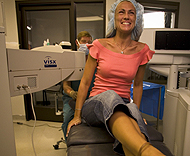LASIK and PRK are both safe and effective laser vision correction procedures that permanently correct myopic, hyperopic, and astigmatic vision. LASIK is generally the favored treatment because it results in less pain, a quicker recovery, and almost immediate results. Yet myself and other surgeons still recommend PRK surgery to a select group of patients. In this post, I review the key differences between the two laser vision correction treatments so our Washington, DC LASIK patients have a better understanding of their options.
Candidates
Candidates for LASIK and PRK surgery must:
- Be at least 18 years old
- Have nearsighted, farsighted, or astigmatic vision
- Have had a stable vision prescription for at least one year
- Not suffer from other serious eye conditions
- Not be pregnant or nursing when they undergo treatment
Unfortunately, some patients are not suitable candidates for LASIK surgery because they have certain corneal conditions such as corneal scars or thin corneas. These patients may be able to undergo LASIK alternatives such as PRK.
Procedure
The LASIK and PRK procedures differ in the way that underlying corneal tissue is exposed to the excimer laser so the cornea can be flattened, steepened, or reshaped. In LASIK surgery, I create a three-sided hinged flap in the outer layer of the cornea using a blade microkeratome or Intralase® laser. The flap is open while the excimer laser reshapes the cornea, then closed so the flap can heal on its own following surgery.
During PRK surgery, the epithelium (the outer layer of the cornea) is completely removed. I then precisely reshape the outer cornea, rather than the inner corneal tissue, with an excimer laser. Finally, bandage contact lenses are applied to the eyes, and must be worn for three to five days after surgery to promote healing and regrowth of the epithelial layer.
Recovery
The LASIK recovery process is quicker and more comfortable than the one experienced by my Washington, DC PRK patients:
- LASIK patients typically experience clear vision the morning that they wake up after surgery. PRK patients may have blurry vision for one to five days after surgery and may not experience their best possible vision until one to six months after surgery.
- LASIK patients do experience some pain about two hours after undergoing surgery, but this usually fades within a few hours. PRK patients may experience discomfort for three to five days after surgery.
- Both LASIK and PRK patients may be given protective eyewear, eye drops, and medication after surgery; PRK patients will also be required to wear bandage contact lenses.
Cost
PRK and LASIK surgery both require the use of advanced laser vision correction technology. Therefore, the cost of both treatments is similar and depends on the degree of the patient’s refractive errors.
If you are interested in undergoing LASIK or PRK surgery, contact my practice today.




